ആഫ്രിക്കയിലെ ലോകപൈതൃകസ്ഥാനങ്ങളുടെ പട്ടിക
(List of World Heritage Sites in Africa എന്ന താളിൽ നിന്നും തിരിച്ചുവിട്ടതു പ്രകാരം)
യുനെസ്കോ (UNESCO) ആഫ്രിക്കയിൽ 135 ലോകപൈതൃകസ്ഥാനങ്ങളാണ് നാമനിർദ്ദേശം ചെയ്തിട്ടുള്ളത്.[i] ഇവ 37 രാജ്യങ്ങളിലായി സ്ഥിതിചെയ്യുന്നു.

no sites
1–2 sites
3–4 sites
5–6 sites
7–8 sites
9 sites
തെരഞ്ഞെടുപ്പ്
എത്യോപ്യ, മൊറോക്കൊ, സൗത്ത് ആഫ്രിക്ക എന്നിവിടങ്ങളിലാണ് ഏറ്റവും കൂടുതൽ ലോകപൈതൃകസ്ഥാനങ്ങൾ ഉള്ളത്, ഒൻപതുവീതം. തുടർന്ന് എട്ടെണ്ണമുള്ള ടുണീഷ്യയും ഏഴെണ്ണം വീതമുള്ള അൾജീറിയയും ഈജിപ്റ്റും, സെനഗലും ടാൻസാനിയയും ഉണ്ട്. പതിനൊന്ന് രാജ്യങ്ങൾക്ക് ഓരോ സ്ഥാനങ്ങൾ ആണ് ഉള്ളത്.
നാലു സ്ഥാനങ്ങൾ രണ്ടുരാജ്യങ്ങൾ പങ്കുവച്ചിരിക്കുന്നു:
- Maloti-Drakensberg Park - ലെസോത്തോയിലും സൗത്ത് ആഫ്രിക്കയിലും .
- Mount Nimba Strict Nature Reserve - ഐവറി കോസ്റ്റിലും ഗിനിയയിലും
- Stone Circles of Senegambia ഗാംബിയയിലും സെനഗലിലും
- Mosi-oa-Tunya / Victoria Falls സാംബിയയിലും സിംബാബ്വെയിലും.
രണ്ടുസ്ഥാനങ്ങൾ മൂന്നുരാജ്യങ്ങൾക്കിടയിൽ പകുത്തിരിക്കുന്നു:
- Sangha Trinational മദ്ധ്യ ആഫ്രിക്കൻ റിപ്പബ്ലിക്കിലും കാമറൂണിലും റിപ്പബ്ലിക്ക് ഓഫ് കോംഗോയിലും
- W-Arly-Penjari Complex ബെനിനിലും ബർക്കിനാ ഫാസോയിലും നൈജറിലും.[1]
പട്ടികയിൽ നിന്നും മനസ്സിലാക്കാൻ
- സ്ഥാനം – ലോകപൈതൃകകമ്മറ്റിയുടെ ഔദ്യോഗികനാമകരണം
- സ്ഥലം – രാജ്യം തിരിച്ച്
- മാനദണ്ഡം – ലോകപൈതൃകകമ്മറ്റി നിശ്ചയിച്ചപ്രകാരം
- Area – ഹെക്ടറിലും ഏക്കറിലും, പൂജ്യമാണെങ്കിൽ, UNESCO അതിനുവിലനൽകിയിട്ടില്ലെന്ന് അർത്ഥം
- വർഷം – ലോകപൈതൃകസ്ഥാനമായി പ്രഖ്യാപിച്ചവർഷം
- വിവരണം – ചെറുവിവരണം
Sites
| സ്ഥാനം | ചിത്രം | സ്ഥലം | തെരഞ്ഞെടുപ്പിന്റെ മാനദണ്ഡം | Area ഹെക്ടർ (ഏക്കർ) | വർഷം | വിവരണം |
|---|---|---|---|---|---|---|
| Aapravasi Ghat | 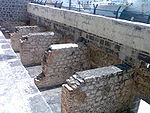 | Port Louis District, Mauritius Mauritius20°09′31″S 57°30′11″E / 20.158611°S 57.503056°E | Cultural: (vi) | 0.16 (0.40) | 2006 | Aapravasi Ghat was the first site chosen by the British government to take part in the "Great Experiment", where indentured laborers were used instead of slaves. Between 1834 and 1920, almost half a million contracted workers passed through Port Louis from India, either to work in Mauritius or to transfer to other British colonies.[2] |
Abu Mena |  | Abusir, Egypt Egypt30°50′28″N 29°39′47″E / 30.84098°N 29.663117°E | Cultural: (iv) | 182 (450) | 1979 | The ruins of the former Christian holy city contain a church, a baptistery, basilicas, public buildings, streets, monasteries, houses, and workshops, and were built over the tomb of Menas of Alexandria.[3] The World Heritage Committee designated Abu Mena as an endangered site in 2001, due to cave-ins in the area caused by the clay at the surface, which becomes semi-liquid when met with "excess water".[4] |
Air and Ténéré Natural Reserves |  | Arlit Department, Niger Niger18°N 9°E / 18°N 9°E | Natural: (vii), (ix), (x) | 7,736,000 (19,120,000) | 1991 | Africa's largest protected area, located in the Saharan desert of Ténéré, consists of the volcanic rock mass of Aïr and a small isolated Sahelian pocket with unique flora and fauna.[5] The natural reserve was placed on UNESCO's List of World Heritage in Danger in 1992, due to the increase in military conflicts and the hostage-taking of six reserve staff in February. Removal from this list was considered in 1999, but as of 2011, its position remains unchanged.[6][7] |
| Aksum |  | Tigray Region, Ethiopia Ethiopia14°07′49″N 38°43′07″E / 14.130190°N 38.718605°E | Cultural: (i), (iv) | — | 1980 | The ruins of the city of Aksum, dating from the 1st to the 13th century, mark the heart of ancient Ethiopia and what was the "most powerful state between the Eastern Roman Empire and Persia". It includes monolithic obelisks, giant stelae, royal tombs, and ruins of former castles.[8] |
| Al Qal'a of Beni Hammad |  | Maadid, Algeria Algeria35°49′06″N 4°47′13″E / 35.818440°N 4.786840°E | Cultural: (iii) | 150 (370) | 1980 | The fortified first capital of the Hammadid emirs was originally built in 1007 and demolished in 1152. It features an 8-bay, 13-aisle mosque, which is one of the largest in Algeria.[9] |
| Aldabra Atoll |  | Aldabra Group, Seychelles Seychelles9°25′00″S 46°25′00″E / 9.416681°S 46.41665°E | Natural: (vii), (ix), (x) | 35,000 (86,000) | 1982 | The Aldabra Atoll consists of four large coral islands and a lagoon, surrounded by a coral reef. The islands are home to the world's largest population of giant tortoises.[10] |
| Amphitheatre of El Jem |  | El Djem, Tunisia Tunisia35°17′47″N 10°42′25″E / 35.296390°N 10.706940°E | Cultural: (iv), (vi) | — | 1979 | The Amphitheatre of El Jem, built during the 3rd century, is North Africa's largest amphitheatre, and the largest one built outside of Italy, with a capacity of 35,000 spectators, and "illustrates the grandeur and extent of Imperial Rome."[11] |
| Ancient Ksour of Ouadane, Chinguetti, Tichitt and Oualata |  | Chinguetti, Ouadane, Oualata, and Tichitt,  Mauritania Mauritania20°55′44″N 11°37′25″W / 20.928890°N 11.623610°W | Cultural: (iii), (iv), (v) | — | 1996 | "Founded in the 11th and 12th centuries to serve the caravans crossing the Sahara, these trading and religious centres became focal points of Islamic culture. [...] Typically, houses with patios crowd along narrow streets around a mosque with a square minaret. They illustrate a traditional way of life centred on the nomadic culture of the people of the western Sahara."[12] |
| Ancient Thebes with its Necropolis |  | Qena, Egypt Egypt25°44′00″N 32°36′00″E / 25.733330°N 32.600000°E | Cultural: (i), (iii), (vi) | 7,390 (18,300) | 1979 | The former capital of Egypt and city of the Egyptian god Amun contains relics from the height of Ancient Egypt. The temples, palaces and the necropolises of the Valley of the Kings and the Valley of the Queens bear "a striking testimony to Egyptian civilization." [13] |
| Archaeological Site of Carthage | 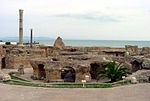 | Tunis, Tunisia Tunisia36°51′10″N 10°19′24″E / 36.852780°N 10.323330°E | Cultural: (ii), (iii), (vi) | — | 1979 | Founded in the 9th century BCE, Carthage was developed into a trading empire spanning the Mediterranean, and was, according to UNESCO, "home to a brilliant civilization." The city was destroyed in 146 BCE in the Punic Wars at the hands of the Romans, but was later rebuilt by these.[14] |
Archaeological Site of Cyrene |  | Jebel Akhdar, Libya Libya32°49′30″N 21°51′30″E / 32.825000°N 21.858330°E | Cultural: (ii), (iii), (vi) | — | 1982 | The formerly Greek colony was Romanized and transformed into a capital, until it was destroyed by the 365 Crete earthquake. The thousand-year-old ruins have remained renowned since the 18th century.[15] |
Archaeological Site of Leptis Magna |  | Khoms, Libya Libya32°38′18″N 14°17′35″E / 32.638330°N 14.293060°E | Cultural: (i), (ii), (iii) | — | 1982 | The Roman city of Leptis Magna was enlarged by Emperor Septimius Severus, who was born there. Public monuments, a harbour, a marketplace, storehouses, shops, and homes were among the reasons for its induction into the list.[16] |
Archaeological Site of Sabratha |  | Sabratha, Libya Libya32°48′19″N 12°29′06″E / 32.805280°N 12.485000°E | Cultural: (iii) | — | 1982 | "A Phoenician trading-post that served as an outlet for the products of the African hinterland, Sabratha was part of the short-lived Numidian Kingdom of Massinissa before being Romanized and rebuilt in the 2nd and 3rd centuries."[17] |
| Archaeological Site of Volubilis |  | Meknes, Morocco Morocco34°04′26″N 5°33′25″W / 34.073890°N 5.556940°W | Cultural: (ii), (iii), (iv), (vi) | 42 (100) | 1997 | The important Roman outpost of Volubilis was founded in the 3rd century BCE to become the capital of Mauretania. It contained many buildings, the remains of which have survived extensively to this day.[18] |
| Archaeological Sites of the Island of Meroe |  | Meroë, Sudan Sudan16°56′00″N 33°43′00″E / 16.933333°N 33.716667°E | Cultural: (ii), (iii), (iv), (v) | 2,357 (5,820) | 2011 | The site was the centre of the Kingdom of Kush, a major force active from the 8th century BCE to the 4th century CE. It is home to pyramids, temples, and domestic buildings, among other vestiges.[19] |
| Asante Traditional Buildings |  | Kumasi, Ghana Ghana6°24′04″N 1°37′33″W / 6.401111°N 1.625833°W | Cultural: (v) | — | 1980 | The site, north-east of Kumasi, hosts the final intact remains of the Ashanti Empire, which peaked in the 18th century. The dwellings, which are made of earth, wood, and straw, are susceptible to the damages caused by the "onslaught of time and weather."[20] |
| Asmara |  | Maekel, Eritrea Eritrea15°20′07″N 38°56′09″E / 15.335277777777778°N 38.935833333333335°E | Cultural: (ii)(iv) | 481 (1,190) | 2017 | Located at over 2000 metres above sea level, the capital of Eritrea developed from the 1890s onwards as a military outpost for the Italian colonial power. After 1935, Asmara underwent a large scale programme of construction applying the Italian rationalist idiom of the time to governmental edifices, residential and commercial buildings, churches, mosques, synagogues, cinemas, hotels, etc.[21] |
| Banc d'Arguin National Park |  | Azefal and Nouadhibou,  Mauritania Mauritania20°14′05″N 16°06′32″W / 20.234720°N 16.108890°W | Natural: (ix), (x) | 1,200,000 (3,000,000) | 1989 | The park consists of sand dunes, coastal swamps, small islands, and shallow bodies of water; all bordering the coast of the Atlantic Ocean. Birds are often found to migrate in the area, accompanied by various species of sea turtles and dolphins, whose presence fishermen often use to attract fish.[22] |
| Bassari Country: Bassari, Fula and Bedik Cultural Landscapes | 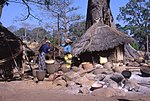 |  Senegal Senegal12°35′36″N 12°50′45″W / 12.593333°N 12.845833°W | Cultural: (iii), (v), (vi) | 50,309 (124,320) | 2012 | [23] |
| Bwindi Impenetrable National Park | 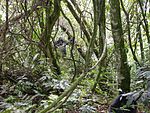 | Kabale District, Kisoro District, and Rukungiri District,  Uganda Uganda1°04′50″S 29°39′41″E / 1.080556°S 29.661389°E | Natural: (vii), (x) | 32,092 (79,300) | 1994 | Located on the border of plain and mountain forests, the park in south-western Uganda is home to over 160 species of trees, over a hundred species of ferns, and various species of birds and butterflies. Many endangered species are within its boundaries as well, including the mountain gorilla.[24] |
| Cape Floral Region Protected Areas | 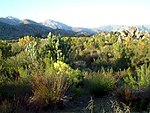 | Eastern Cape and Western Cape,  South Africa South Africa34°21′40″S 18°28′30″E / 34.361111°S 18.475000°E | Natural: (ix), (x) | 553,000 (1,370,000) | 2004 | The site consists of eight protected areas that are among the richest in plant life worldwide, containing nearly 20% of Africa's total flora. Its scientific value is demonstrated by the presence of fire and radiation adaptivity in plants and seed dispersal by insects.[25] |
| Chongoni Rock-Art Area |  | Dedza District, Malawi Malawi14°17′36″S 34°16′45″E / 14.293333°S 34.279167°E | Cultural: (iii), (vi) | 12,640 (31,200) | 2006 | The 127-site area contains the richest concentration of rock art in Central Africa, ranging from Stone Age paintings to contemporary work from farmers. The symbols depicted in the rock art are strongly centred around women, and retain a cultural significance for the Chewa.[26] |
| Cidade Velha, Historic Centre of Ribeira Grande |  | Ribeira Grande, Cape Verde Cape Verde14°54′55″N 23°36′19″W / 14.915139°N 23.605194°W | Cultural: (ii), (iii), (vi) | 209 (520) | 2009 | The town, south of the island of Santiago, was the first European colonial outpost in the tropics, with remains dating back to the 16th century. Two churches, a royal fortress, and Pillary Square help comprise the tropical town's original street layout.[27] |
| Cliff of Bandiagara (Land of the Dogons) |  | Bandiagara Cercle, Mali Mali14°20′00″N 3°25′00″W / 14.333330°N 3.416670°W | Mixed: (v), (vii) | 327,390 (809,000) | 1989 | The sandy plateau and cliffs of Bandiagara outline the site, featuring houses, granaries, altars, sanctuaries, and Togu-Na meeting-places. Age-old social traditions such as masks, feasts, rituals, and ancestral worship also add to its cultural significance.[28] |
Comoé National Park |  | Zanzan, Côte d'Ivoire Côte d'Ivoire9°N 4°E / 9°N 4°E | Natural: (ix), (x) | 1,150,000 (2,800,000) | 1983 | Among the largest protected sites of West Africa, the park features the Comoé River and the unique flora which accompanies it.[29] The site was placed on UNESCO's List of World Heritage in Danger in 2003, due to unrest in Côte d'Ivoire, and various other factors such as poaching, wildfires, lack of proper management of the site, and overgrazing.[30] |
| Dja Faunal Reserve |  | Dja-et-Lobo and Haut-Nyong,  Cameroon Cameroon3°N 13°E / 3°N 13°E | Natural: (ix), (x) | 526,000 (1,300,000) | 1987 | Among Africa's largest and best protected rain forests, the Cameroonian reserve is almost completely surrounded by the Dja River and contains 107 mammal species, of which five are threatened.[31] |
| Djémila | 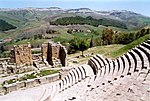 | Sétif, Algeria Algeria36°19′14″N 5°44′12″E / 36.320560°N 5.736670°E | Cultural: (iii), (iv) | 30 (74) | 1982 | The ruins of a Roman town in a mountainous location, including a forum, temples, basilicas, triumphal arches and houses, each adapted to a location 900 m (3,000 ft) above sea level.[32] |
| Djoudj National Bird Sanctuary |  | Saint-Louis Region, Senegal Senegal16°30′00″N 16°10′00″W / 16.500000°N 16.166670°W | Natural: (vii), (x) | 16,000 (40,000) | 1981 | The Senegal River delta wetland area consists of streams, lakes, ponds and backwaters. It is the home to 1.5 million birds, including the great white pelican, the purple heron, the African spoonbill, the great egret, and cormorants. The sanctuary also features crocodiles, African manatees, and other typical Sahelian species.[33] |
| Dougga / Thugga |  | Béja Governorate, Tunisia Tunisia36°25′25″N 9°13′13″E / 36.423610°N 9.220280°E | Cultural: (ii), (iii) | 70 (170) | 1997 | The site features the ruins of Dougga, a former capital of a Libyan–Punic state, which flourished under Ancient Rome and the Byzantine Empire, but declined in the Islamic period.[34] |
| Ecosystem and Relict Cultural Landscape of Lopé-Okanda |  | Ogooué-Ivindo and Ogooué-Lolo,  Gabon Gabon0°30′N 11°30′E / 0.5°N 11.5°E | Mixed: (iii), (iv), (ix), (x) | 491,291 (1,214,010) | 2007 | The park features well-preserved tropical rain forests and savanna, resulting in a diverse ecosystem consisting of endangered, large mammals.[35] |
| Ennedi Massif: Natural and Cultural Landscape |  |  Chad Chad17°02′30″N 21°51′46″E / 17.04167°N 21.86278°E | Mixed: (iii), (vii), (ix) | 2,441,200 (6,032,000) | 2016 | [36] |
| Fasil Ghebbi, Gondar Region |  | Amhara Region, Ethiopia Ethiopia12°36′25″N 37°27′58″E / 12.606920°N 37.466170°E | Cultural: (ii), (iii) | — | 1979 | The fortress was the residence of the Ethiopian emperors during the 16th and 17th century. The city remains, which feature buildings with Hindu and Arab influences, were later remodelled with Baroque-style architecture by Jesuit missionaries.[37] |
| Fort Jesus, Mombasa |  | Mombasa, Kenya Kenya4°03′46″S 39°40′46″E / 4.062778°S 39.679444°E | Cultural: (i), (iv) | 161,485 (399,040) | 2011 | Fort Jesus is a Portuguese fort built from 1593 to 1596 on Mombasa Island to guard the old port of Mombasa, Kenya. The site's layout follows the Renaissance ideal that the human body is perfectly proportionate.[38] |
| Forts and Castles, Volta, Greater Accra, Central and Western Regions | 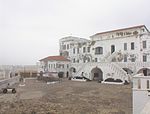 | Central Region, Greater Accra, Volta Region, and Western Region,  Ghana Ghana5°14′51″N 0°47′07″W / 5.247398°N 0.785167°W | Cultural: (vi) | — | 1979 | The site features the remains of fortified trading posts, built along the Ghanaian coast between 1482 and 1786.[39] |
| Fossil Hominid Sites of South Africa[ii] |  | Gauteng, Limpopo, and North West,  South Africa South Africa24°09′31″S 29°10′37″E / 24.158610°S 29.176940°E | Cultural: (iii), (vi) | — | 1999 | The various fossil sites contain traces of human occupation and evolution dating 3.3 million years.[40] |
| Garajonay National Park | 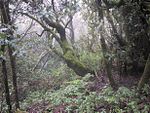 | La Gomera, Spain Spain28°07′34″N 17°14′14″W / 28.126250°N 17.237222°W | Natural: (vii), (ix) | 3,984 (9,840) | 1986 | Most of the park, in the middle of the island of La Gomera of the Canary Islands, is covered with a lush laurel forest.[41] |
Garamba National Park | 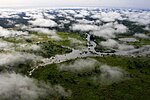 | Orientale, Democratic Republic of the Congo Democratic Republic of the Congo4°00′N 29°15′E / 4°N 29.25°E | Natural: (vii), (x) | 500,000 (1,200,000) | 1980 | The park has vast savannas, grasslands and woodland, featuring elephants, giraffes, hippopotamuses and the white rhinoceros.[42] Garamba was deemed to be endangered following the diminution of the white rhinoceros population in the area,[43] but it was removed from the list in 1991.[44] However, it later regained the status in 1996, when three rangers were killed and the population of white rhinoceros fell once again.[45][46] |
| Gebel Barkal and the Sites of the Napatan Region | 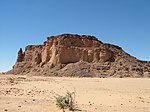 | Meroë, Sudan Sudan18°32′00″N 31°49′00″E / 18.533333°N 31.816667°E | Cultural: (i), (ii), (iii), (iv), (vi) | 183 (450) | 2003 | The five sites in the Nile Valley feature temples that are testimonial to the Napatan and Meroitic cultures.[47] |
| Gough and Inaccessible Islands | 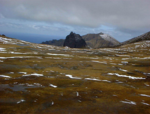 | Saint Helena, United Kingdom United Kingdom40°19′29″S 9°55′43″W / 40.324722°S 9.928611°W | Natural: (vii), (x) | 7,900 (20,000) | 1995 | The site represent one of the least-disrupted islands and marine ecosystems in the North Temperate Zone. The cliffs are free of introduced mammals and feature one of the world's largest colonies of seabirds.[48] |
| Great Zimbabwe National Monument |  | Masvingo Province, Zimbabwe Zimbabwe20°17′00″S 30°56′00″E / 20.283333°S 30.933333°E | Cultural: (i), (iii), (vi) | 722 (1,780) | 1986 | The city, now in ruins, was an important trading center between the 11th and 15th centuries, and was capital of the Bantu civilization.[49] |
| Harar Jugol, the Fortified Historic Town |  | Harari Region, Ethiopia Ethiopia9°18′32″N 42°08′16″E / 9.308889°N 42.137778°E | Cultural: (ii), (iii), (iv), (v) | 48 (120) | 2006 | The city is on a plateau and surrounded by gorges and savanna. It contains 82 mosques, 102 shrines, and unique interior design in the townhouses. It is said to be the fourth-holiest city of Islam.[50] |
| Historic Cairo | 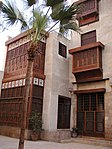 | Cairo, Egypt Egypt30°03′00″N 31°15′40″E / 30.050000°N 31.261110°E | Cultural: (i), (v), (vi) | 524 (1,290) | 1979 | One of the world's oldest Islamic cities and in the middle of urban Cairo, the site dates from the 10th century and reached its golden age in the 14th century. It contains mosques, madrasah, hammams and fountains.[51] |
| Historic Centre of Agadez |  | Tchirozerine Department, Niger Niger16°58′25″N 7°59′29″E / 16.973611°N 7.991389°E | Cultural: (ii), (iii) | 78 (190) | 2013 | [52] |
| Historic City of Meknes | 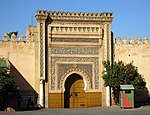 | Meknes, Morocco Morocco33°53′00″N 5°33′30″W / 33.883330°N 5.558330°W | Cultural: (iv) | — | 1996 | The former capital was founded in the 11th century and turned into a city with Spanish-Moorish influence during the 17th and 18th centuries.[53] |
| Historic Town of Grand-Bassam |  | Sud-Comoé, Côte d'Ivoire Côte d'Ivoire5°11′45″N 3°44′11″W / 5.195914°N 3.736369°W | Cultural: (iii), (iv) | 110 (270) | 2012 | A colonial town built during the 19th and 20th centuries, Grand-Bassam was the first Ivorian capital following French rule in the region. Its quarters, which specialised in commerce, administration and general housing, helped the city become the economic and judicial hub of the country, in addition to being its most important port.[54] |
| Ichkeul National Park | 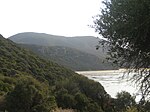 | Bizerte, Tunisia Tunisia37°09′49″N 9°40′29″E / 37.163610°N 9.674720°E | Natural: (x) | 12,600 (31,000) | 1980 | Ichkeul Lake and the surrounding wetlands is a destination for hundreds of thousands of migrating birds, including ducks, geese, storks and pink flamingos. It was once part of a chain that extended across North Africa.[55] |
| iSimangaliso Wetland Park | 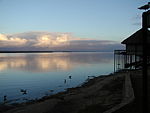 | KwaZulu-Natal, South Africa South Africa27°50′20″S 32°33′00″E / 27.838890°S 32.550000°E | Natural: (vii), (ix), (x) | 239,566 (591,980) | 1999 | The park features a variety of landforms, including coral reefs, long sandy beaches, coastal dunes, lake systems, and papyrus wetland, caused by fluvial, marine and aeolian processes.[56] |
| Island of Gorée |  | Dakar Region, Senegal Senegal14°40′02″N 17°24′03″W / 14.667220°N 17.400830°W | Cultural: (vi) | — | 1978 | The island was the largest slave-trading center on the African coast from the 15th to the 19th century.[57] |
| Island of Mozambique |  | Nampula, Mozambique Mozambique15°02′03″S 40°44′09″E / 15.034170°S 40.735830°E | Cultural: (iv), (vi) | — | 1991 | The fortified former Portuguese trading post has used the same architectural techniques, style, and materials since the 16th century.[58] |
| Island of Saint-Louis | 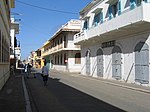 | Saint-Louis Region, Senegal Senegal16°01′40″N 16°30′16″W / 16.027780°N 16.504440°W | Cultural: (ii), (iv) | — | 2000 | The French colonial settlement from the 17th century is on an island in the mouth of the Sénégal River. It played an important role in the culture and economy of West Africa.[59] |
Kahuzi-Biega National Park |  | Maniema and South Kivu,  Democratic Republic of the Congo Democratic Republic of the Congo2°30′N 28°45′E / 2.5°N 28.75°E | Natural: (x) | 600,000 (1,500,000) | 1980 | The park is dominated by two extinct volcanoes, Kahuzi and Biega. It also has abundant fauna, including the graueria gorillas.[60] The park was deemed to be endangered in 1997 when deforestation and hunting became a major problem. Militia groups and illegal settlers were also settling in the park, while fire and poaching helped justify the World Heritage Committee's decision.[61] |
| Kairouan | 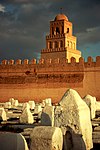 | Kairouan Governorate, Tunisia Tunisia35°40′54″N 10°06′14″E / 35.681670°N 10.103890°E | Cultural: (i), (ii), (iii), (v), (vi) | — | 1988 | The former capital was founded in 670 and flourished in the 9th century. Its heritage includes the Mosque of Uqba and the Mosque of the Three Gates.[62] |
| Kasbah of Algiers |  | Algiers, Algeria Algeria36°47′00″N 3°03′37″E / 36.783330°N 3.060280°E | Cultural: (ii), (v) | 60 (150) | 1992 | A unique Islamic city on the Mediterranean coast, the former site overlooks the Carthaginian trading posts of the 4th century BCE. It contains remains of a citadel, old mosques, and Ottoman-style palaces.[63] |
| Kenya Lake System in the Great Rift Valley |  | Rift Valley Province, Kenya Kenya0°26′33″N 36°14′24″E / 0.442500°N 36.240000°E | Natural: (viii), (x) | 161,485 (399,040) | 2011 | Located in the Great Rift Valley, Kenya, the site features three lakes: Lake Bogoria, Lake Nakuru and Lake Elementaita. A highly diverse population of birds, including thirteen threatened species, frequent the area.[64][65] |
| Khami Ruins National Monument |  | Matabeleland, Zimbabwe Zimbabwe20°09′30″S 28°22′36″E / 20.158333°S 28.376667°E | Cultural: (iii), (iv) | — | 1986 | The city was built after the mid-16th century and was an important trading center.[66] |
| ǂKhomani Cultural Landscape | Northern Cape, South Africa South Africa25°41′15″S 20°22′29″E / 25.68761111111111°S 20.374583333333334°E | Cultural: (iii), (iv), (v), (vi) | 959,100 (2,370,000) | 2017 | The ǂKhomani Cultural Landscape is located at the border with Botswana and Namibia in the northern part of the country, coinciding with the Kalahari Gemsbok National Park (KGNP). The large expanse of sand contains evidence of human occupation from the Stone Age to the present and is associated with the culture of the formally nomade ǂKhomani San people and the strategies that allowed them to adapt to harsh desert conditions.[67] | |
| Kilimanjaro National Park |  | Kilimanjaro Region, Tanzania, United Republic of Tanzania, United Republic of3°04′00″S 37°22′00″E / 3.066670°S 37.366670°E | Natural: (vii) | 75,575 (186,750) | 1987 | The volcanic massif Mount Kilimanjaro is Africa's highest point at 5,895 metres (19,341 ft), and is surrounded by a park with savanna and forest featuring numerous mammals.[68] |
| Kondoa Rock-Art Sites | Kondoa District, Tanzania, United Republic of Tanzania, United Republic of4°43′28″S 35°50′02″E / 4.724444°S 35.833889°E | Cultural: (iii), (vi) | 233,600 (577,000) | 2006 | Two millennia of rock carving, many of high artistic value, have been found at 150 shelters in the site. They tell the tale of socio-economic development from hunter-gatherer to agro-pastoralism.[69] | |
| Konso Cultural Landscape |  | Southern Nations, Nationalities, and People's Region, Ethiopia Ethiopia5°18′N 37°24′E / 5.3°N 37.4°E | Cultural: (iii), (v) | 14,000 (35,000) | 2011 | The site features 55 kilometres (34 mi) of stonewalled terraces and fortified settlements in the Konso highlands of Ethiopia.[70] |
| Koutammakou, the Land of the Batammariba | 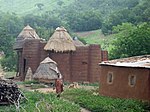 | Kara Region, Togo Togo10°04′00″N 1°08′00″E / 10.066667°N 1.133333°E | Cultural: (v), (vi) | 50,000 (120,000) | 2004 | The Batammariba's mud tower houses have become a symbol of Togo. They range up to two stories and feature spherical granaries.[71] |
| Ksar of Ait-Ben-Haddou | 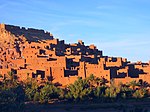 | Aït Benhaddou, Morocco Morocco31°02′50″N 7°07′44″W / 31.047220°N 7.128890°W | Cultural: (iv), (v) | 3 (7.4) | 1987 | The ksar is an example of a traditional pre-Saharan habitat, surrounded by high walls and reinforced with corner towers.[72] |
| Kunta Kinteh Island and Related Sites[iii] |  | Banjul, Lower Niumi, and Upper Niumi,  Gambia Gambia13°18′58″N 16°21′26″W / 13.316166°N 16.357194°W | Cultural: (iii), (vi) | 8 (20) | 2003 | The site is a testimony to the encounters between Africa and Europe from pre-colonial times to independence along the Gambia River.[73] |
| Lake Malawi National Park |  | Central Region and Southern Region,  Malawi Malawi14°02′00″S 34°53′00″E / 14.033330°S 34.883330°E | Natural: (vii), (ix), (x) | 9,400 (23,000) | 1984 | Lake Malawi contains hundreds of fish species, mostly endemic.[74] |
| Lakes of Ounianga |  | Ennedi Region, Chad Chad19°03′18″N 20°30′20″E / 19.055000°N 20.505556°E | Natural: (vii) | 62,808 (155,200) | 2012 | The Lakes of Ounianga are a series of 18 lakes located in the Sahara desert, in North-Eastern Chad. They exhibit a variety of sizes, depths, chemical compositions and colorations, and some of them are home to aquatic fauna.[75] |
| Lake Turkana National Parks |  | Lake Turkana, Kenya Kenya3°03′05″N 36°30′13″E / 3.051306°N 36.503667°E | Natural: (viii), (x) | 161,485 (399,040) | 1997 | Turkana, as Africa's largest saline lake, is an important area for the study of fauna and flora. It is a breeding ground for the Nile crocodile, hippopotamus and several venomous snakes.[76] |
| Lamu Old Town |  | Lamu, Kenya Kenya2°16′05″S 40°54′07″E / 2.268°S 40.902°E | Cultural: (ii), (iv), (vi) | 16 (40) | 2001 | The town is the oldest Swahili settlement, and is built in coral stone and mangrove timber. It features inner courtyards, verandas, and elaborate wooden doors.[77] |
| Laurisilva of Madeira |  | Madeira, Portugal Portugal32°46′00″N 17°00′00″W / 32.766667°N 17°W | Natural: (ix), (x) | 15,000 (37,000) | 1999 | The site is the largest surviving area of laurel forest. It consists of approximately 90% old-growth forest and is home to endemic species such as the Madeiran long-toed pigeon.[78] |
| Le Morne Cultural Landscape |  | Rivière Noire District, Mauritius Mauritius20°27′07″S 57°19′42″E / 20.451944°S 57.328333°E | Cultural: (iii), (vi) | 349 (860) | 2008 | The rugged mountain that juts into the ocean was used as a shelter by runaway slaves through the 18th and early 19th centuries. They formed small settlements in the caves and on its summit.[79] |
| Lower Valley of the Awash |  | Afar Region, Ethiopia Ethiopia11°06′00″N 40°34′46″E / 11.100060°N 40.579390°E | Cultural: (ii), (iii), (iv) | — | 1980 | Palaentological findings from at least four million years ago, such as Lucy, give evidence of human evolution.[80] |
| Lower Valley of the Omo | 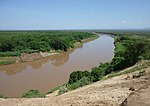 | Southern Nations, Nationalities, and People's Region, Ethiopia Ethiopia4°48′00″N 35°58′00″E / 4.8°N 35.966667°E | Cultural: (iii), (iv) | — | 1980 | The prehistoric site near Lake Turkana is the location of many fossil findings, such as Homo gracilis.[81] |
| M'Zab Valley |  | Ghardaïa, Algeria Algeria32°29′00″N 3°41′00″E / 32.483330°N 3.683330°E | Cultural: (ii), (iii), (v) | 4,000 (9,900) | 1982 | The intact, traditional human habitat was built around five ksour in the 10th century by the Ibadites.[82] |
| Maloti-Drakensberg Park |  | Qacha's Nek District, Lesotho* Lesotho*KwaZulu-Natal,  South Africa* South Africa*29°45′55″S 29°07′23″E / 29.765278°S 29.123056°E | Mixed: (i), (iii), (vii), (x) | 249,313 (616,070) | 2000 | The park features incisive dramatic cutbacks, golden sandstone ramparts, and the largest concentration of cave art in Sub-Saharan Africa.[83] |
| Mana Pools National Park, Sapi and Chewore Safari Areas | 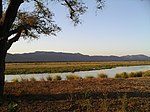 | Matabeleland North, Zimbabwe Zimbabwe15°49′10″S 29°24′29″E / 15.819444°S 29.408056°E | Natural: (vii), (ix), (x) | 676,600 (1,672,000) | 1984 | The park, located on the banks of the Zambezi River, features a variety of wild animals, such as buffalo, leopards, cheetahs and Nile crocodiles.[84] |
Manovo-Gounda St. Floris National Park |  | Bamingui-Bangoran, Central African Republic Central African Republic9°00′N 21°30′E / 9°N 21.5°E | Natural: (ix), (x) | 1,740,000 (4,300,000) | 1988 | The park features vast savannas with a wealth of flora and fauna, such as black rhinoceros, elephants, cheetahs, leopards, wild dogs, red-fronted gazelles and buffalo.[85] The site was placed on the List of World Heritage in Danger in 1997 due to grazing and poaching that is thought to have claimed 80% of the wildlife in the park. Also cited was the shooting of four park staff and "a general state of deteriorating security".[86] |
| Mapungubwe Cultural Landscape | 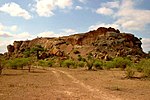 | Limpopo, South Africa South Africa22°11′33″S 29°14′20″E / 22.192500°S 29.238890°E | Cultural: (ii), (iii), (iv), (v) | 28,168 (69,600) | 2003 | The open savanna landscape lies at the confluence of the Limpopo and Shashe Rivers. It was the heart of the Mapungubwe Kingdom until the 14th century, when the area was abandoned, leaving untouched remains of palaces and settlements.[87] |
| Matobo Hills |  | Matabeleland South, Zimbabwe Zimbabwe20°30′S 28°30′E / 20.5°S 28.5°E | Cultural: (iii), (v), (vi) | 205,000 (510,000) | 2003 | The large boulders have been used as natural shelters since the early Stone Age and feature a collection of rock paintings.[88] |
| Mbanza-Kongo | Zaire Province, Angola Angola6°16′04″S 14°14′53″E / 6.267778°S 14.248056°E | Cultural: (iii), (iv), (vi) | 89.29 (220.6) | 2017 | The town of Mbanza Kongo, located on a plateau at an altitude of 570 metres, was the political and spiritual capital of the Kingdom of Kongo, one of the largest constituted states in Southern Africa from the 14th to 19th centuries.[89] | |
| Medina of Essaouira (formerly Mogador) |  | Essaouira, Morocco Morocco31°31′00″N 9°46′10″W / 31.516670°N 9.769440°W | Cultural: (ii), (iv) | 30 (74) | 2001 | The fortified seaport built during the late 18th century has a mix of North African and European architecture, and was a major trading hub between the Sahara and Europe.[90] |
| Medina of Fez | 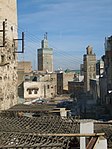 | Fez, Morocco Morocco34°03′40″N 4°58′40″W / 34.061110°N 4.977780°W | Cultural: (ii), (v) | 280 (690) | 1981 | The former capital was founded in the 9th century and features the world's oldest university. The urban fabric and main monuments date from the 13th and 14th centuries.[91] |
| Medina of Marrakesh | 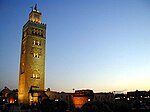 | Marrakesh, Morocco Morocco31°37′53″N 7°59′12″W / 31.631390°N 7.986670°W | Cultural: (i), (ii), (iv), (v) | 1,107 (2,740) | 1985 | The town was founded in the 1070s and remained a political, economic, and cultural centre for a long time. Monuments from that period include the Koutoubia Mosque, the kasbah, and the battlements. The city also holds newer features, including palaces.[92] |
| Medina of Sousse | 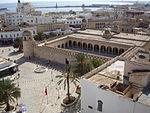 | Sousse Governorate, Tunisia Tunisia35°49′40″N 10°38′19″E / 35.827780°N 10.638610°E | Cultural: (iii), (iv), (v) | 32 (79) | 1988 | A prime example of a town from the early Islamic period, the city was an important port during the 9th century.[93] |
| Medina of Tétouan (formerly known as Titawin) | 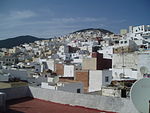 | Tétouan, Morocco Morocco35°34′15″N 5°22′00″W / 35.570830°N 5.366670°W | Cultural: (ii), (iv), (v) | 7 (17) | 1997 | Morocco's most complete medina served as the main point of contact between Morocco and Andalusia during the 8th century. The town was rebuilt by Andalusian refugees following the reconquista.[94] |
| Medina of Tunis |  | Tunis, Tunisia Tunisia36°49′00″N 10°10′00″E / 36.816670°N 10.166670°E | Cultural: (ii), (iii), (v) | — | 1979 | The medina holds 700 monuments, including palaces, mosques, mausoleums, madrasah and fourtains, testifying to Tunis' golden age from the 12th to the 16th century.[95] |
| Memphis and its Necropolis – the Pyramid Fields from Giza to Dahshur |  | Giza, Egypt Egypt29°58′34″N 31°07′49″E / 29.976040°N 31.130410°E | Cultural: (i), (iii), (vi) | 16,358 (40,420) | 1979 | The former capital features funerary monuments, like rock tombs, mastabas, temples, and pyramids. It is one of the Seven Wonders of the Ancient World.[96] |
| Mosi-oa-Tunya / Victoria Falls |  | Livingstone District and Matabeleland North,  Zambia* Zambia* Zimbabwe* Zimbabwe*17°55′28″S 25°51′19″E / 17.924530°S 25.855390°E | Natural: (vii), (viii) | 8,780 (21,700) | 1989 | The falls of the Zambezi River, which is more than 2 km (1.2 mi) wide, plunge down various basalt gorges resulting in a colorful mist.[97] |
| Mount Kenya National Park/Natural Forest |  | Central Province and Eastern Province,  Kenya Kenya0°09′18″N 37°18′56″E / 0.155000°N 37.315556°E | Natural: (vii), (ix) | 142,020 (350,900) | 1997 | The park surrounds the 5,199 m (17,057 ft) Mount Kenya and features twelve glaciers.[98] |
Mount Nimba Strict Nature Reserve | 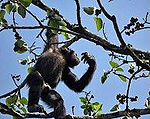 | Lola Prefecture, Côte d'Ivoire* Côte d'Ivoire* Guinea* Guinea*7°36′11″N 8°23′27″W / 7.603180°N 8.390970°W | Natural: (ix), (x) | 18,000 (44,000) | 1981 | The reserve features Mount Nimba, its slopes covered in dense forest and grassy mountain pastures.[99] In 1992, the park was inscribed on the World Heritage Committee's danger list, citing a proposed iron and ore mining concession inside the park's boundaries and the apparition of refugees. The state party later stated that there was an error with the proposed mining site's boundaries, and that it was not in the reserve.[100] However, as of 2011, the site remains on the list due to poor security on the Ivorian side.[101] |
| Namib Sand Sea |  |  Namibia Namibia24°53′07″S 15°24′28″E / 24.885278°S 15.407778°E | Natural: (vii), (viii), (ix), (x) | 3,077,700 (7,605,000) | 2013 | [102] |
| Ngorongoro Conservation Area |  | Arusha Region, Tanzania, United Republic of Tanzania, United Republic of3°11′14″S 35°32′27″E / 3.187220°S 35.540830°E | Mixed: (iv), (vii), (viii), (ix), (x) | 809,440 (2,000,200) | 1979 | The site features a concentration of wild animals in a crater beside the active volcano Oldonyo Lengai.[103] |
Niokolo-Koba National Park |  | Kédougou Region and Tambacounda Region,  Senegal Senegal13°04′00″N 12°43′00″W / 13.066670°N 12.716670°W | Natural: (x) | 913,000 (2,260,000) | 1981 | The forests and savannas bordering the Gambia River have a diverse fauna, including Derby eland, chimpanzees, lions, birds, reptiles, and amphibians.[104] The park was listed as being endangered for low mammal populations, the construction of a dam, and management problems.[105] |
| Nubian Monuments from Abu Simbel to Philae |  | Aswan, Egypt Egypt22°20′11″N 31°37′34″E / 22.336390°N 31.626110°E | Cultural: (i), (iii), (vi) | 374 (920) | 1979 | Located along the Nile, the site contains monuments such as the Temple of Ramesses II and the Sanctuary of Isis.[106] |
Okapi Wildlife Reserve |  | Orientale, Democratic Republic of the Congo Democratic Republic of the Congo2°00′N 28°30′E / 2°N 28.5°E | Natural: (x) | 1,372,625 (3,391,830) | 1996 | Covering a fifth of the Ituri Rainforest in the Congo River basin, the reserve contains many threatened species of primates and birds. It is inhabited by the nomadic pygmy Mbuti and Efé tribes.[107] In 1997, looting, the killing of elephants, and the departure of reserve staff led the World Heritage Committee to place the reserve on its List of World Heritage in Danger, only a year following its inscription as a natural heritage site.[108] |
| Okavango Delta |  | Orientale, Botswana Botswana19°17′00″S 22°54′00″E / 19.283333°S 22.9°E | Natural: (x) | 2,023,590 (5,000,400) | 2014 | [109] |
Old Towns of Djenné | 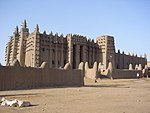 | Djenné, Mali Mali13°54′23″N 4°33′18″W / 13.906390°N 4.555000°W | Cultural: (iii), (iv) | — | 1988 | Inhabited since 250 BCE, the city was an important link in the trans-Saharan gold trade. It contains 2,000 traditional houses.[110] |
Old Town of Ghadamès | 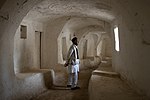 | Ghadames, Libya Libya30°08′00″N 9°30′00″E / 30.133333°N 9.5°E | Cultural: (v) | — | 1986 | Located in an oasis, Ghadames is one of the oldest pre-Saharan cities and represents a traditional architecture with vertical division of functions.[111] |
| Osun-Osogbo Sacred Grove |  | Osogbo, Nigeria Nigeria7°45′20″N 4°33′08″E / 7.755560°N 4.552220°E | Cultural: (ii), (iii), (vi) | 75 (190) | 2005 | The dense forests are one of the final remnants of high forests in southern Nigeria. It is the last sacred grove of the Yoruba culture.[112] |
| Pitons, Cirques and Remparts of Reunion Island |  | La Réunion, France France21°05′58″S 55°28′48″E / 21.099444°S 55.480000°E | Natural: (vii), (x) | 105,838 (261,530) | 2010 | Outstanding terrain and biodiversity, as part of La Réunion National Park.[113] |
| Portuguese City of Mazagan (El Jadida) |  | El Jadida, Morocco Morocco33°15′24″N 8°30′07″W / 33.256670°N 8.501940°W | Cultural: (ii), (iv) | 8 (20) | 2004 | The fortification, akin to Renaissance military design from the early 16th century, was taken over by Morocco in 1769. Surviving buildings include the cistern and a Gothic church.[114] |
| Punic Town of Kerkuane and its Necropolis |  | Nabeul Governorate, Tunisia Tunisia36°56′47″N 11°05′57″E / 36.946390°N 11.099170°E | Cultural: (iii) | — | 1985 | The city was abandoned in 250 BCE during the First Punic War, and is the only surviving example of a Phoenicio–Punic settlement.[115] |
| Rabat, Modern Capital and Historic City: a Shared Heritage |  | Rabat-Salé-Zemmour-Zaer, Morocco Morocco34°01′27″N 6°49′22″W / 34.024167°N 6.822778°W | Cultural: (ii), (iv) | 349 (860) | 2012 | Rebuilt under the direction of the French from 1912 to the 1930s, the city blends historic and modern features, such as botanical gardens, the Hassan Mosque, and the remnants of Moorish and Andalusian settlements from the 17th century.[116] |
Rainforests of the Atsinanana |  | Eastern Madagascar, Madagascar Madagascar14°27′35″S 49°42′09″E / 14.459722°S 49.702500°E | Natural: (ix), (x) | 479,660 (1,185,300) | 2007 | The site consists of six national parks, and protects the island's unique biodiversity, which has evolved in isolation for 60 million years.[117] The park was deemed to be in danger in 2010, when logging and hunting activities continued to escalate, despite a ban by Madagascar on exporting illegal timber.[118] |
| Richtersveld Cultural and Botanical Landscape |  | Northern Cape, South Africa South Africa28°36′00″S 17°12′14″E / 28.6°S 17.203889°E | Cultural: (iv), (v) | 160,000 (400,000) | 2007 | The mountainous desert sustains the semi-nomadic livelihood of the Nama, which includes seasonal migrations that have gone unchanged for two millennia.[119] |
| Robben Island |  | Western Cape, South Africa South Africa33°48′00″S 18°22′00″E / 33.8°S 18.366667°E | Cultural: (iii), (vi) | 475 (1,170) | 1999 | Between the 17th and 20th century, the island was used as a prison, including for political prisoners, a hospital for socially unacceptable groups, and a military base.[120] |
Rock-Art Sites of Tadrart Acacus | 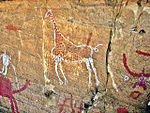 | Fezzan, Libya Libya24°50′00″N 10°20′00″E / 24.833330°N 10.333330°E | Cultural: (iii) | — | 1985 | Thousands of cave paintings are visible in different styles, dating from 12,000 BCE to 100 CE.[121] |
| Rock-Hewn Churches, Lalibela | 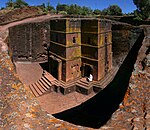 | Amhara Region, Ethiopia Ethiopia12°01′46″N 39°02′26″E / 12.029350°N 39.040420°E | Cultural: (i), (ii), (iii) | — | 1978 | The site contains eleven medieval cave churches from the 13th century.[122] |
| Royal Hill of Ambohimanga |  | Antananarivo, Madagascar Madagascar18°45′33″S 47°33′46″E / 18.759170°S 47.562780°E | Cultural: (iii), (iv), (vi) | 59 (150) | 2001 | The royal city and burial site is a spiritual and sacred site which has created strong feelings of national identity for several centuries.[123] |
| Royal Palaces of Abomey | 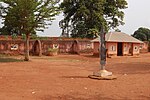 | Zou Department, Benin Benin7°11′00″N 1°59′00″E / 7.183333°N 1.983333°E | Cultural: (iii), (iv) | 48 (120) | 1985 | The city held the seat of twelve kings who ruled the Kingdom of Dahomey between 1625 and 1900. All but one king built their palace within the area.[124] |
| Ruins of Kilwa Kisiwani and Ruins of Songo Mnara |  | Kilwa District, Tanzania, United Republic of Tanzania, United Republic of8°57′28″S 39°31′22″E / 8.957780°S 39.522780°E | Cultural: (iii) | — | 1981 | The site features the remains of two ports used extensively for trade across the Indian Ocean from the 13th and 16th century.[125] It was placed onto the list of List of World Heritage in Danger by the World Heritage Committee in 2004, citing "the continuing deterioration and the serious threats affecting the property of the Ruins of Kilwa Kisiwani and Songo Mnara".[126] Conditions subsequently improved and the site was removed from the World Heritage in Danger list in 2014.[127] |
| Ruins of Loropéni | 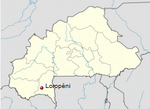 | Loropéni, Burkina Faso Burkina Faso10°15′00″N 3°35′00″W / 10.25°N 3.583333°W | Cultural: (iii) | 1.1 (2.7) | 2009 | More than a thousand years old, Loropéni is the best-preserved of ten fortresses in Lobi, which were part of about a hundred stone enclosures built during the trans-Saharan gold trade.[128] |
| Rwenzori Mountains National Park |  | Bundibugyo District, Kabarole District, and Kasese District,  Uganda Uganda0°13′25″N 29°55′27″E / 0.223611°N 29.924167°E | Natural: (vii), (x) | 99,600 (246,000) | 1994 | Covering most of the Rwenzori Mountains, including Mount Margherita, Africa's third-highest peak, the park features glaciers, waterfalls and lakes in an Alpine landscape. It also features various endangered species and unusual flora.[129] |
| Sacred Mijikenda Kaya Forests | 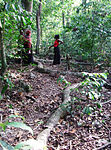 | Coast Province, Kenya Kenya3°55′55″S 39°35′46″E / 3.931944°S 39.596111°E | Cultural: (iii), (v), (vi) | 1,538 (3,800) | 2008 | The site comprises eleven forests spread 200 km (120 mi) along the coast of Kenya. They hold the remains of villages built during the 16th century by the Mijikenda, and are now considered sacred sites.[130] |
| Saint Catherine Area | 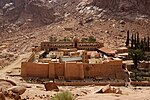 | South Sinai Governorate, Egypt Egypt28°33′22″N 33°58′32″E / 28.556230°N 33.975430°E | Cultural: (i), (iii), (iv), (vi) | 60,100 (149,000) | 2002 | The orthodox monastery from the 6th century is positioned near Mount Horeb where, according to the Old Testament, Moses received the Tablets of the Law. The region is sacred for Christians, Muslims and Jews.[131] |
Salonga National Park |  | Maniema and South Kivu,  Democratic Republic of the Congo Democratic Republic of the Congo2°S 21°E / 2°S 21°E | Natural: (vii), (ix) | 3,600,000 (8,900,000) | 1984 | Africa's largest tropical rain forest reserve is situated at the heart of the Congo River basin and only accessible by water. It is the habitat of endangered species such as the bonobo, the Congo peafowl, the forest elephant, and the slender-snouted crocodile.[132] The site was deemed to be in danger in 1999, due to increased poaching activities and encroachments.[133] |
| Saloum Delta |  |  Senegal Senegal13°50′07″N 16°29′55″W / 13.835278°N 16.498611°W | Cultural: (iii), (iv), (v) | 145,811 (360,310) | 2011 | The area has sustained human life thanks to fishing and shellfish gathering, for which there are 218 shellfish mounds across the site.[134] |
| Sanganeb Marine National Park and Dungonab Bay – Mukkawar Island Marine National Park |  Sudan Sudan19°44′10″N 37°26′35″E / 19.73611°N 37.44306°E | Natural: (vii), (ix), (x) | 199,524 (493,030) | 2016 | Situated in the central Red Sea, Sanganeb, Dungonab Bay and Mukkawar Island feature a diverse system of coral reefs, mangroves, seagrass beds, beaches and islets, and host populations of seabirds, marine mammals, fish, sharks, turtles, manta rays and dugongs.[135] | |
| San Cristóbal de la Laguna |  | Province of Santa Cruz de Tenerife, Spain Spain28°28′40″N 16°18′42″W / 28.477889°N 16.311778°W | Cultural: (ii), (iv) | 60 (150) | 1999 | The city contains two centres: the unplanned Upper Town, and the planned Lower Town, laid out according to philosophical principals. Many of the buildings date from the 16th to the 18th centuries.[136] |
| Sangha Trinational | 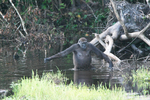 |  Cameroon* Cameroon* Central African Republic* Central African Republic* Congo* Congo*2°36′34″N 16°33′15″E / 2.609444°N 16.554167°E | Natural: (ix), (x) | 746,309 (1,844,170) | 2012 | [137] |
Selous Game Reserve |  | Lindi Region, Morogoro Region, Mtwara Region, Pwani Region, and Ruvuma Region,  Tanzania, United Republic of Tanzania, United Republic of9°00′S 37°24′E / 9°S 37.4°E | Natural: (ix), (x) | 5,000,000 (12,000,000) | 1982 | The park's vegetation varies from dense thickets to open wooded grasslands, and features large numbers of elephants, black rhinoceros, cheetahs, giraffes, hippos and crocodiles.[138] It was placed onto the list of List of World Heritage in Danger by the World Heritage Committee in 2014 due to widespread poaching, especially of elephants and rhinoceros.[139] |
| Serengeti National Park |  | Arusha Region, Mara Region, and Shinyanga Region,  Tanzania, United Republic of Tanzania, United Republic of2°20′00″S 34°34′00″E / 2.333330°S 34.566670°E | Natural: (vii), (x) | 1,476,300 (3,648,000) | 1981 | The vast savanna is known for the annual migration for herds of wildebeest, gazelle, zebras, and their predators.[140] |
Simien National Park | 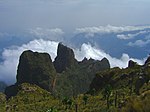 | Amhara Region, Ethiopia Ethiopia13°11′00″N 38°04′00″E / 13.183333°N 38.066667°E | Natural: (vii), (x) | 22,000 (54,000) | 1978 | The eroded Ethiopian plateau comprises jagged mountain peaks, deep valleys, and sharp precipices dropping about 1,500 m (4,900 ft).[141] The decrease of the walia ibex, bushbuck, and bushpig populations, as well as an increase of the human population in the park prompted the World Heritage Committee to place it on their List of World Heritage in Danger in 1996.[142] |
| Stone Circles of Senegambia | 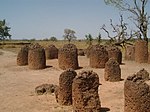 | Central River Division and Kaolack Region,  Gambia* Gambia* Senegal* Senegal*13°41′28″N 15°31′21″W / 13.691111°N 15.522500°W | Cultural: (i), (iii) | 10 (25) | 2006 | The groups of stone circles are among over 1,000 different monuments along the Gambia River. Used as burial grounds, they were erected between the 3rd century BCE and the 16th century CE.[143] |
| Stone Town of Zanzibar |  | Zanzibar, Tanzania, United Republic of Tanzania, United Republic of6°09′47″S 39°11′21″E / 6.163060°S 39.189170°E | Cultural: (ii), (iii), (vi) | 96 (240) | 2000 | A prime example of an East African coastal trading town, its urban fabric and townscape remains intact.[144] |
| Sukur Cultural Landscape |  | Madagali, Nigeria Nigeria10°44′26″N 13°34′19″E / 10.740560°N 13.571940°E | Cultural: (iii), (v), (vi) | — | 1999 | The site features the Palace of the Hidi, terraced fields, and the remains of a former iron industry.[145] |
| Taï National Park | 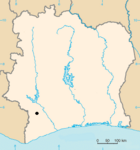 | Guiglo and Sassandra,  Côte d'Ivoire Côte d'Ivoire5°45′00″N 7°07′00″W / 5.750000°N 7.116667°W | Natural: (vii), (x) | 330,000 (820,000) | 1982 | One of few remaining sections of the West African tropical forest, the park features a rich flora, including eleven species of monkeys.[146] |
| Tassili n'Ajjer |  | Illizi and Tamanrasset,  Algeria Algeria25°30′N 9°00′E / 25.5°N 9°E | Mixed: (i), (iii), (vii), (viii) | 7,200,000 (18,000,000) | 1982 | The site is in a landscape with 15,000 cave engravings that record climatic changes, animal migrations, and the evolution of human life, dating from 6,000 BCE to the first centuries CE.[147] |
| Teide National Park |  | Province of Santa Cruz de Tenerife, Spain Spain28°16′17″N 16°38′37″W / 28.271389°N 16.643611°W | Natural: (vii), (viii) | 18,990 (46,900) | 2007 | The national park features the Teide stratovolcano, which at 3,718 m (12,198 ft) is Spain's tallest mountain and the world's third-tallest volcano.[148] |
Timbuktu |  | Timbuktu Cercle, Mali Mali16°46′24″N 2°59′58″W / 16.773333°N 2.999444°W | Cultural: (ii), (iv), (v) | — | 1988 | The city was a centre for the propagation of Islam in the 15th and 16th centuries, and features three mosques and many madrasahs.[149] The sites were deemed endangered after the Battle of Gao in June 2012, which followed several weeks of constant threats to the area. Days later, some sites within Timbuktu were destroyed by Ansar Dine, an Islamist group, citing religious reasons.[150] |
| Timgad |  | Batna Province, Algeria Algeria35°29′03″N 6°28′07″E / 35.484167°N 6.468611°E | Cultural: (ii), (iii), (iv) | 0.04 (0.099) | 1982 | A military colony built by Emperor Trajan in 100 CE, the site features cardo and decumanus streets, typical of a Roman town.[151] |
| Tipasa | 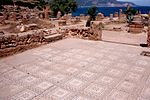 | Tipaza, Algeria Algeria36°35′31″N 2°26′58″E / 36.591944°N 2.449444°E | Cultural: (iii), (iv) | 52 (130) | 1982 | First a Carthaginian trading center, Tipasa was converted into a military base by the Romans. Heavy Christian influences can be seen from the 3rd and 4th centuries, though Tipasa went into steady decline in the Byzantine period.[152] |
| Tiya | 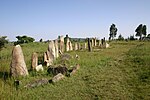 | Southern Nations, Nationalities, and People's Region, Ethiopia Ethiopia8°26′06″N 38°36′44″E / 8.434910°N 38.612100°E | Cultural: (i), (iv) | — | 1980 | The archaeological site contains 36 monuments, which includes 32 carved stelae covered with symbols hard to decrypt.[153] |
Tomb of Askia | 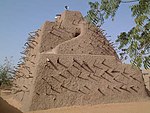 | Gao Region, Mali Mali16°17′23″N 0°02′40″E / 16.289800°N 0.044560°E | Cultural: (ii), (iii), (iv) | 4 (9.9) | 2004 | Built in 1495, the pyramid was built as a tomb for Emperor Askia Mohamed. It represents the power of an empire that controlled the trans-Saharan gold trade.[154] The site was deemed endangered after the Battle of Gao in June 2012, which followed several weeks of constant threats to the area.[155] |
Tombs of Buganda Kings at Kasubi | 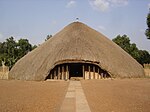 | Kampala District, Uganda Uganda0°20′55″N 32°33′05″E / 0.348611°N 32.551389°E | Cultural: (i), (iii), (iv), (vi) | 27 (67) | 2001 | The tombs, built after 1884, are a major example of prime architecture using organic materials, principally wood, thatch, reed, and wattle and daub.[156] The tombs were almost completely destroyed by a fire in March 2010, prompting the World Heritage Committee to reluctantly mark the site as being in danger. The Ugandan government has since called for the reconstruction of the tombs, and UNESCO has agreed to mobilise funds for the project.[157][158] |
| Tsingy de Bemaraha Strict Nature Reserve | 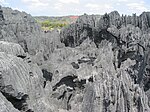 | Melaky, Madagascar Madagascar18°40′00″S 44°45′00″E / 18.666670°S 44.75°E | Natural: (vii), (x) | 152,000 (380,000) | 1990 | The canyon of the Manambolo River comprises karstic and limestone landscapes cut into peaks and a forest of limestone needles. It also holds undisturbed forests, lakes and mangrove swamps, which are the habitat for lemurs and birds.[159] |
| Tsodilo |  | North-West, Botswana Botswana18°45′00″S 21°44′00″E / 18.75°S 21.733333°E | Cultural: (i), (iii), (vi) | 4,800 (12,000) | 2001 | The site features more than 4,500 rock art paintings in the Kalahari Desert. Archaeological records provide evidence of human and environmental activities ranging over 100,000 years.[160] |
| Twyfelfontein or /Ui-//aes |  | Kunene, Namibia Namibia20°35′44″S 14°22′21″E / 20.595583°S 14.372583°E | Cultural: (iii), (v) | 57 (140) | 2007 | The site has one of the largest concentrations of rock engravings in Africa, which range from a period of over 2,000 years.[161] |
| Vallée de Mai Nature Reserve |  | Praslin, Seychelles Seychelles4°19′45″S 55°44′15″E / 4.329170°S 55.737500°E | Natural: (vii), (viii), (ix), (x) | 20 (49) | 1983 | The natural palm forest is preserved in almost its original state.[162] |
Virunga National Park | 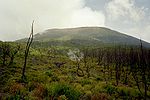 | North Kivu and Orientale,  Democratic Republic of the Congo Democratic Republic of the Congo0°55′00″N 29°10′00″E / 0.916667°N 29.166667°E | Natural: (vii), (viii), (x) | 800,000 (2,000,000) | 1979 | The park comprises swamps, savannas, and snowfields.[163] Virunga was inscribed on the World Heritage Committee's List of World Heritage in Danger in 1994, due to the war in Rwanda and the subsequent increase of the refugee population in the park, deforestation, poaching, departure of park staff, and depletion of forests.[164] |
| Vredefort Dome | 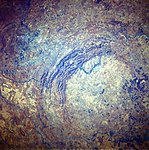 | Free State and North West,  South Africa South Africa26°52′S 27°16′E / 26.86°S 27.26°E | Natural: (viii) | 30,000 (74,000) | 2005 | The crater, with a diameter of 190 km (120 mi), is the largest, oldest, and most deeply eroded astrobleme found on Earth, dating back more than two billion years.[165] |
| W-Arly-Pendjari Complex | 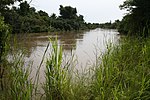 |  Benin; Benin; Burkina Faso; Burkina Faso; Niger Niger11°53′3″N 2°29′16″E / 11.88417°N 2.48778°E | Natural: (ix), (x) | 1,494,831 (3,693,810); buffer zone 1,101,221 (2,721,180) | 1996[iv] | The parks are in the zone between savanna and forest lands, and are an important ecosystem for the biogeographical area.[166] |
| Wadi Al-Hitan (Whale Valley) |  | Faiyum Governorate, Egypt Egypt29°20′00″N 30°11′00″E / 29.333330°N 30.183330°E | Natural: (viii) | 20,015 (49,460) | 2005 | Located in western Egypt, the site contains fossil remains of the now extinct Archaeoceti, mapping the evolution of the whales from a land-based to an aquatic mammal.[167] |
കുറിപ്പുകൾ
ഇവയും കാണുക
- Lists of World Heritage Sites
അവലംബം
പുറത്തേക്കുള്ള കണ്ണികൾ
- agoras.typepad.fr/regard_eloigne/dominique-sewane/
- www.sciencespo.fr/psia/users/dominiquesewane
- http://www.unesco.org/fr/university-twinning-and-networking/access-by-region/africa/togo/unesco-chair-in-influence-of-african-thought-preservation-of-african-cultural-heritage-718/
🔥 Top keywords: പി.എൻ. പണിക്കർവായനദിനംതുഞ്ചത്തെഴുത്തച്ഛൻബിഗ് ബോസ് (മലയാളം സീസൺ 6)കുമാരനാശാൻഈദുൽ അദ്ഹവള്ളത്തോൾ നാരായണമേനോൻപ്രധാന താൾപ്രത്യേകം:അന്വേഷണംഉള്ളൂർ എസ്. പരമേശ്വരയ്യർചെറുശ്ശേരിവൈക്കം മുഹമ്മദ് ബഷീർസുഗതകുമാരിമലയാളം അക്ഷരമാലആധുനിക കവിത്രയംചങ്ങമ്പുഴ കൃഷ്ണപിള്ളപാത്തുമ്മായുടെ ആട്ആടുജീവിതംബാബർകുഞ്ചൻ നമ്പ്യാർമലയാളംഒ.എൻ.വി. കുറുപ്പ്പ്രാചീനകവിത്രയംമധുസൂദനൻ നായർഅക്ബർകുഞ്ഞുണ്ണിമാഷ്ഇന്ത്യൻ പാർലമെന്റ്കഥകളിഹുമായൂൺമുഗൾ സാമ്രാജ്യംഎസ്.കെ. പൊറ്റെക്കാട്ട്കേരളംജഹാംഗീർഷാജഹാൻചണ്ഡാലഭിക്ഷുകികമല സുറയ്യതകഴി ശിവശങ്കരപ്പിള്ളഔറംഗസേബ്എം.ടി. വാസുദേവൻ നായർ